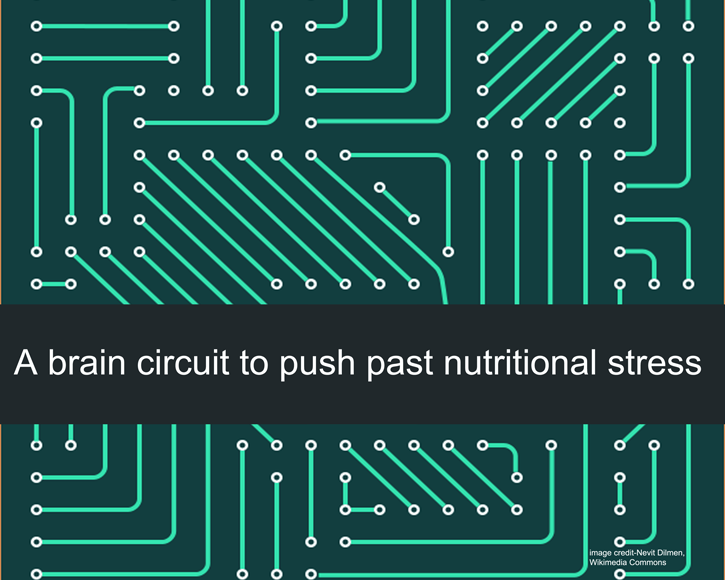It is past lunch time and your stomach is growling with hunger. Your last meal was a coffee and cookie this morning. Regardless, you have to power through; you have to finish that project before you can take a break and a missed meal is not going to stop you from working.
When we go hungry, we have the ability to ignore the urge to eat such that we can carry out the task at hand. It has long been known that the brain is involved in such decisions. But how the brain coordinates the response to nutritional stress so that the body can function normally is not understood very well. Now, researchers from the National Centre for Biological Sciences (NCBS), Bangalore, have discovered a brain circuit that allows fruit flies to take a major developmental step in their lives despite nutritional stress.
From the time they hatch out of eggs, insects such as flies undergo three major stages in their lives. The first is the maggot-like larval stage during which the insect eats and builds up resources; the second is the transformatory pupa stage, from which the legless, wingless larvae emerge into the third and final adult stage of their lives as 6-legged, winged flies.
Integrating nutrition sensing with these developmental steps is important; the larva must know when it has enough resources to pupate and make the transformation into an adult. When deprived of food, pupation can often be postponed until enough reserves been accumulated.
However, there are exceptions to this - when faced with protein deprivation towards the end of their larval lives, fruit fly larvae are able to push themselves to pupate. Gaiti Hasan's team from NCBS has now uncovered how this happens - the researchers have discovered an integrative circuit of nerve cells in fruit fly brains that allows them to ignore the lack of proteins in their food to enter the pupal stage.
"Larvae basically decide to pupate once they have eaten enough. But at a stage where they have already got enough protein in them, if you give them protein-deficient food, they hit a dilemma. Normal larvae have a neuronal circuit in their brains that let them get over this. However, we have a set of mutants that cannot pupate under this condition," says Gaiti Hasan. "In actual fact, these mutants have everything in them to be able to pupate, but because this circuit is not functioning properly, they are unable to ignore the protein deficit," she continues.
The circuit Hasan's group has discovered consists of three types of nerve cells - one set senses and reports the lack of protein in food, a second set integrates this input with metabolic information and the third set controls the hormonal signals necessary to begin pupation. The nerve cells involved in integration and control of hormonal signals reside in an area of the insect brain known as the mid-Ventral Ganglion (mVG), which in turn communicates with a central brain region that is akin to the mammalian hypothalamus.
Studies on the hypothalamus have shown that it integrates nutrition sensing to metabolic processes and regulates hunger. In a similar manner, the insect mVG, also combines information about nutrition with metabolic inputs. However, the circuit in the fly's mVG described in this work functions to regulate a developmental step in the insect's life, unlike a behavioural urge like hunger that the hypothalamus regulates in mammals.
"What is really amazing about this work is that it demonstrates that a pure signalling pathway from a neuronal system can control a developmental switch - the one that tells a larva to become a pupa," says Siddharth Jayakumar, Hasan's student and the lead author of the paper that details these findings in the journal eLife.
Hasan and Jayakumar believe that the "integrator circuit" linking nutrition and development that they have uncovered could be similar in insects and mammals. Although the types of nerve cells involved in the two systems maybe very different, the circuit patterns are highly likely to be similar.
"We think that the activity pattern we see in the fly brain could easily function even in a complex system like the mammal nervous system," says Jayakumar. "The mammalian hypothalamic region is evolutionarily related to a region in the ventral ganglion of insects. So by studying the simpler insect system, you can glean some parallels to the how the mammalian hypothalamus receives and integrates external nutritional information. This could give us insights into developmental decisions taken by the brain of a growing embryo to overcome nutritional stress," he adds.
The work described in this press release has been published as a paper titled "Drosophila larval to pupal switch under nutrient stress requires IP3R/Ca2+ signalling in glutamatergic interneurons" in the journal eLife in August 2016. The paper can be accessed here: https://elifesciences.org/content/5/e17495








0 Comments